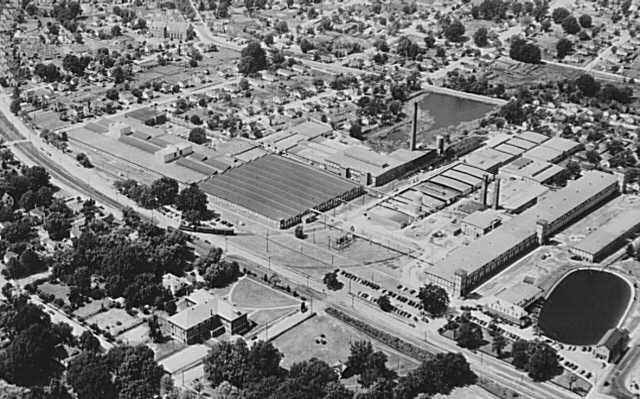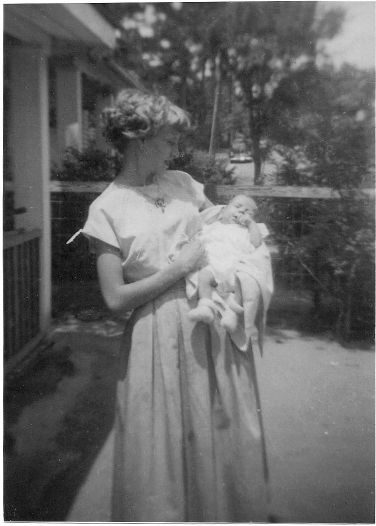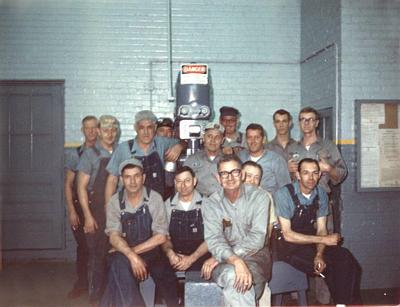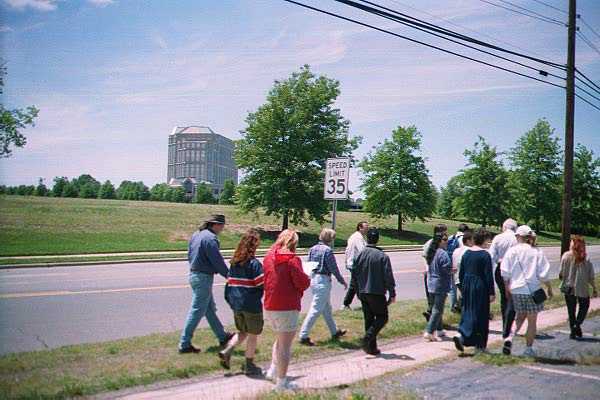The Changing Landscape of the Erwin Mills Area
The
twin arrivals of Trinity College and Erwin Mills in 1892 would transform
West Durham forever. No single event was more important to Old West Durham
than the arrival of Erwin Cotton Mills. According to author, Jean Anderson,
the two-story brick factory included a picker building, dyehouse, boiler
room, and engine house. The mills had 11,000 spindles and 360 looms producing
a variety of fabrics. Rows of neat houses were built for the workers.
By 1895, some 375 families were living in the mill village which is, today,
the heart of a national historic district.
Today, the large Erwin Cotton mills building on the left is gone; an office tower occupies the space (below, left). The area above where the water tower stands (now torn down) is currently open space. The long building on the right still exists; it has been renovated for use as apartments and offices (below, right).


View
from Hillsborough Road of the open field where mills once stood.

An aerial view of Erwin Cotton Mills. The old West Durham
post office is located in the bottom-right corner of the
photo (on the corner of West Main and Ninth Street next to
the mill pond -- where Wachovia Bank is today). Across Main
Street (to the left) is the old Erwin Auditorium -- Durham's
first park. The park was lost to the Durham Freeway. At the
top of the photo, mill houses can be seen -- right up to the
walls of the mill. Several of the homes closest to the mills
were torn down (where Kerr Drugs and the neighborhood
"greenspace" on Hillsborough Road are today). Greystone
Baptist Church can barely be seen at the top-left (where
Hillsborough Road turns toward Hillandale Road). From the
Greater Durham Chamber of Commerce Papers.
Another view of the mills, with mill
houses among the industrial buildings (below).
 |
Lois Bennett Ramsey and daughter in the mill village on Case Street. |

Erwin Mills Machine Shop (ca. 1967): close group of men who often spent time together after work fishing and having "fish fry" cook-outs at "Cabes Ford" (located at the end of Cole Mill Road). First row: Calvin Cagle, Robert King Sr., Hubert Maddry, Vernon James and J.C. "Jake" Blackwood. Second row: Bill Gebhart, Robert Lancaster, unidentified, Charlie Martin and Al Todd. Third row: Bill Dezern, James Harper, Paul "Toots" Browning and an unidentified worker. (Photo courtesy of Norman Pendergrass)
From Mills to More (Urban Land Institute, April 2003)
Despite problems, developers and architects throughout the Southeast are working to convert former textile mills into multifamily properties.
Between 1880 and 1920, the heart of the U.S. textile industry shifted from New England to the Southeast, where labor was still relatively cheap. Expansion to the southern states was swift. In North Carolina alone, more than six new mills were built each year between 1880 and 1900, reports Gerald Ingalls, director of Public Policy at the University of North Carolina in Charlotte. "By 1900, there were 177 mills in the state." The South´s importance in the textile industry lasted for about a century, but with globalization and inexpensive labor available elsewhere in the world, U.S. production declined steadily for a number of decades, leaving empty mills scattered about the Southeast.
The silver lining in this economic shift is that many of these mills are the original buildings constructed during the wave of expansion at the end of the 19th century and the beginning of the 20th century and they remain architecturally significant, structurally imposing, and strong enough for adaptive use. Many are being turned into lofts, apartments, and affordable housing.
Erwin Cotton Mills
Other than the establishment of Trinity College, the most important event in the commercial history of the West Durham neighborhood in Durham, North Carolina, was the building of the Erwin Cotton Mills in 1893, boasting 11,000 spindles and 360 looms. When homes were built for workers, 375 families moved in, creating a "mill village."
The end of the line for Erwin Mills came in 1986 and soon after some of the structures were torn down. All the workers lost their jobs and the neighborhood hit rock bottom, remembers John Schelp, president of the Old West Durham Neighborhood Association. To make matters worse, a mall opened outside of town and the neighborhood´s once vibrant Ninth Street soon was left with only vacant storefronts.
By the late 1980s, however, efforts began to revive Erwin Mills. Although one of the old buildings was torn down and a modern, mid-rise built in its place, another of the larger structures was saved and renovated for use as apartments and offices. "It was a beautiful building with large windows and brick arches," says Schelp. "And the effort to revitalize that mill was a shot in the arm for the neighborhood, setting off a ripple effect in new development projects."
New, high-density apartments are to be built in the open area behind the mill. "It will all be red brick with historic touches," Schelp notes. Ninth Street has been most affected, he says. "All the shops are full—with a lot of restaurants, everything from Lebanese to sushi. It has really changed."
When the wheels of Erwin Mills were ready to turn
in 1893, a local editorial declared: "The anti-trust shriekers went
into their closets and wept bitterly
over the hopeless degeneracy of the times, painfully and pathetically
recalling with regret the good old days when every man made his own homespun,
dined on ash cake and drank sassafras tea for breakfast."
-Al Fairbrother (Durham Daily Globe, 31 March 1893)



